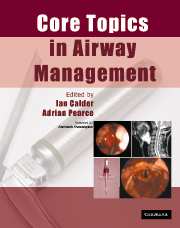Book contents
- Frontmatter
- Contents
- List of contributors
- Preface
- Acknowledgements
- List of abbreviations
- 1 Anatomy
- 2 Physiology of apnoea and hypoxia
- 3 Physics and physiology
- 4 Cleaning and disinfection of airway equipment
- 5 General principles
- 6 Maintenance of the airway during anaesthesia: supra-glottic devices
- 7 Tracheal tubes
- 8 Tracheal intubation of the adult patient
- 9 Confirmation of tracheal intubation
- 10 Extubation
- 11 Light-guided intubation: the trachlight
- 12 Fibreoptic intubation
- 13 Retrograde intubation
- 14 Endobronchial and double-lumen tubes, bronchial blockers
- 15 ‘Difficult airways’: causation and prediction
- 16 The paediatric airway
- 17 Obstructive sleep apnoea and anaesthesia
- 18 The airway in cervical trauma
- 19 The airway in cervical spine disease and surgery
- 20 The aspiration problem
- 21 The lost airway
- 22 Trauma to the airway
- 23 Airway mortality associated with anaesthesia and medico-legal aspects
- 24 ENT and maxillofacial surgery
- 25 Airway management in the ICU
- 26 The airway in obstetrics
- Index
24 - ENT and maxillofacial surgery
Published online by Cambridge University Press: 15 December 2009
- Frontmatter
- Contents
- List of contributors
- Preface
- Acknowledgements
- List of abbreviations
- 1 Anatomy
- 2 Physiology of apnoea and hypoxia
- 3 Physics and physiology
- 4 Cleaning and disinfection of airway equipment
- 5 General principles
- 6 Maintenance of the airway during anaesthesia: supra-glottic devices
- 7 Tracheal tubes
- 8 Tracheal intubation of the adult patient
- 9 Confirmation of tracheal intubation
- 10 Extubation
- 11 Light-guided intubation: the trachlight
- 12 Fibreoptic intubation
- 13 Retrograde intubation
- 14 Endobronchial and double-lumen tubes, bronchial blockers
- 15 ‘Difficult airways’: causation and prediction
- 16 The paediatric airway
- 17 Obstructive sleep apnoea and anaesthesia
- 18 The airway in cervical trauma
- 19 The airway in cervical spine disease and surgery
- 20 The aspiration problem
- 21 The lost airway
- 22 Trauma to the airway
- 23 Airway mortality associated with anaesthesia and medico-legal aspects
- 24 ENT and maxillofacial surgery
- 25 Airway management in the ICU
- 26 The airway in obstetrics
- Index
Summary
Difficult airway management problems are encountered more commonly during anaesthesia for ear, nose and throat (ENT) and maxillofacial procedures than probably any other branch of surgery. Surgery varies from high volume cases such as tonsillectomy and dento-alveolar surgery to complex head and neck cancer and craniofacial surgery. For a successful outcome these shared airway procedures require thorough pre-operative evaluation and close co-operation between anaesthetist and surgeon with an understanding of each other's problems and knowledge of specialist equipment.
General ENT and maxillofacial procedures
Airway management for ENT and maxillofacial procedures needs to take account of specific problems and a number of techniques may be useful (Table 24.1):
Once surgery has commenced the anaesthetist is remote from the airway making adjustments to the airway more difficult and disruptive.
Head and neck positioning for surgery and movements during surgery require a secure airway.
For nasal and intraoral surgery the airway requires protection by soiling from blood and debris.
Oropharyngeal and nasopharyngeal packs should be specifically recorded and accounted for at the end of the procedure.
Direct inspection and suction clearance of blood and debris from the oro–nasopharynx should be undertaken at the end of the procedure.
Face mask
Until the introduction of the laryngeal mask airway (LMA) many simple ear procedures were undertaken with a face mask. The increased use of the LMA, compared to a face mask, for simple ear procedures is due to its ability to provide a clearer airway with a more effective airtight seal allowing better ventilation and monitoring of tidal gases. The anaesthetist's hands are also freed and factors which make facemask anaesthesia difficult, for example the edentulous bearded patient, have little impact on the quality of the airway with an LMA.
- Type
- Chapter
- Information
- Core Topics in Airway Management , pp. 177 - 190Publisher: Cambridge University PressPrint publication year: 2005
- 1
- Cited by



